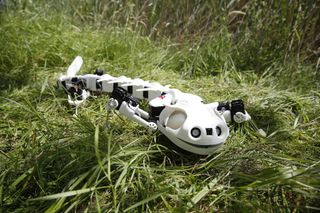
New Robo-Salamander Can Really Move

With the help of X-ray videos, scientists have developed a new robot that mimics the way salamanders walk and swim.
The amphibious machine could shed light on the evolutionary leap that vertebrates made from the water to the land, the researchers said. The salamander-inspired robot could also one day be used for search-and-rescue missions or inspection operations, the scientists added.
In general, scientists investigate animal locomotion for insights that could, among other things, help people recover from devastating losses of mobility, said study senior author Auke Ijspeert, a bioroboticist at the Swiss Federal Institute of Technology in Lausanne. [The 6 Strangest Robots Ever Created]
Increasingly, scientists are creating robot copies of animals to perform such investigations of animal locomotion. One of the benefits of using robots is that the machines' actions are relatively easy to repeat, Ijspeert and his colleagues said. In addition, researchers can tinker with robot shapes in a methodical way, and the bots can perform movements that are unnatural or dangerous for animals, the scientists added.
The researchers focused on salamanders to shed light on the evolution of animal locomotion. "Salamanders have a body structure that is very close to the fossils of the first terrestrial vertebrates — that is, the first animals that switched from swimming to walking," Ijspeert told Live Science.
To create robo-salamanders, the researchers began by studying Pleurodeles waltl, a salamander about 7 inches (18 centimeters) long that moves both on land and in the water. The scientists took X-ray videos of two P. waltl specimens from the top and sides, tracking up to 64 points along the skeletons of the salamanders as they performed a variety of motions, such as walking on the ground, crawling underwater and even swimming.
The scientists then used a 3D printer to manufacture the skeleton of the robot. Onto this machine, they added 27 motors and a waterproof dry suit that was tailor-made to keep the robots' electronics from getting wet.
Sign up for the Live Science daily newsletter now
Get the world’s most fascinating discoveries delivered straight to your inbox.
The so-called Pleurobot has fewer bones and joints than real-life salamanders. For instance, whereas the real amphibian has 40 vertebrae, the robot has only 11 segments along its spine mimicking vertebrae. [Super-Intelligent Machines: 7 Robotic Futures]
Still, the researchers said Pleurobot could imitate many salamander movements, especially at the limbs. This is because during the design of Pleurobot, the research team's computer models identified the minimum number of motorized segments needed to copy salamander motions, as well as the optimal placement of these parts along the robot's body.
The researchers have built salamander robots before. However, "what excites me most about Pleurobot is that for the first time we can test behaviors with a physical body that has the ability to move like the real animal, as never before," Ijspeert said.
"The robot can serve as a scientific tool to investigate how a newer mode of locomotion, walking with limbs, can be added to an older mode of locomotion, swimming," Ijspeert said. "Like the real salamander, the robot is able to perform both modes of locomotion. Both involve body undulations, but with different properties. During swimming, the undulations travel along the body like in lampreys and eels, with limbs folded backwards, while during walking, they stay in place and are well-coordinated with the limb movements in order to optimize forward speed."
In addition to providing insights on the evolution of animal locomotion, Pleurobot may also show how robots can move well in disorderly environments, Ijspeert said. "With improved control and sturdier mechanics, I hope to see Pleurobot helping in search-and-rescue scenarios in the near future," he said.
The scientists detailed their findings online June 29 in the journal Interface.
Original article on Live Science.
